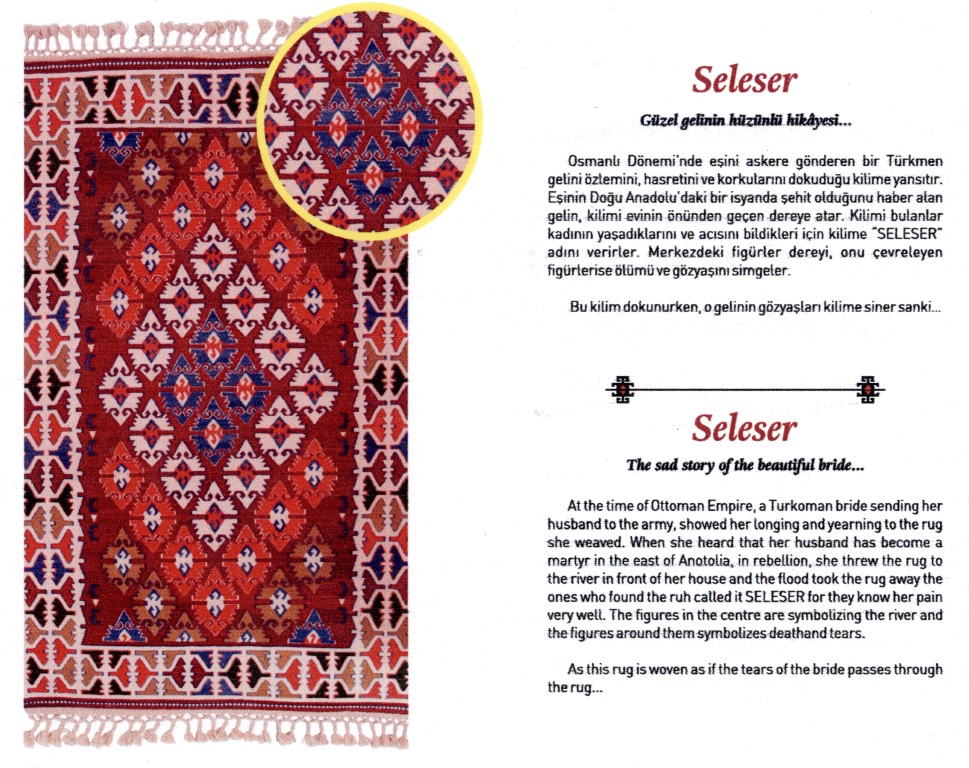Asarcik
The life styles of the mighty dynasty’…
At the time of Seljuk Empire, The Bayat Clan has settled in this region, located on top of high plains in this region, which resembles to a castle. Turkish teenager girls have weaved perfectly the place of this first settlement of Bayat clan into a rug. The figures surrounded by red stripes on top of the rug symbolizes the protecting watts built against enemies. The shapes inside counts for residencies and the triangle tent in the middle shows the power of the throne. Below the red stripes are presenting the agricultural areas. Arrow like figures surrounding the castle symbolizes the relation of Bayat clan with other clans. With the scale image of Bayat town represents the justice and protection for other towns around. Our women keep alive this historical moment knot by knot in ‘Asarcik’ rug…
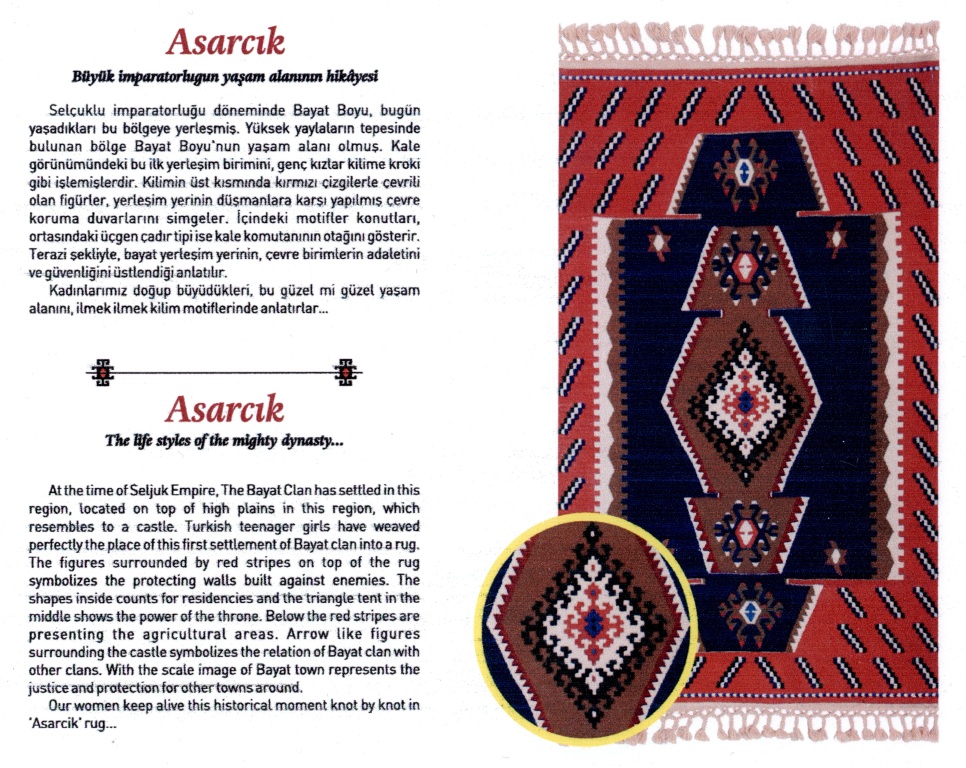
Beauty Of Avsar
The Story of a heavenly beautiful bride.
It is known that Turkish people has been separated to lots of clans. This rug, which has come Bayat in the dowry of a girl from the Avşar clan of Oğuz, is loved so much among Bayat girls. It is believed her name is given by a shepherd. Our young ladies wove the beauties of Avsar girls in this rug with handicraft.
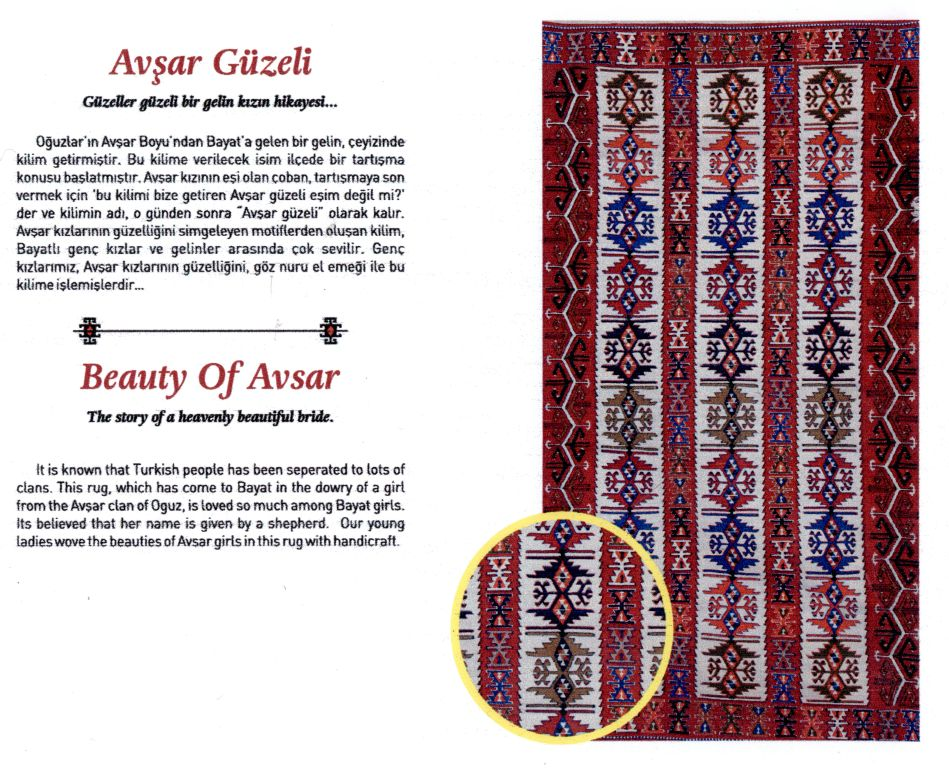
Basakli Rug
The story of Fertility…
This rug reflects the value Turkish nation gives to agriculture and soil. Via this rug the importance the products taken from the soil are stressed out for progression of life. “Başaklı Rug” is a indicator of happiness for married couple’s houses and blessings of their marriages despite lots of difficulties. This rug is laid on the surface in new couple’s house to give them fertility. The zigzag line in the Basakli Rug- says that the marriage of new couple goes like this but never draw apart. The red surface of the rug symbolizes the sincerity. love and strength of weaver; green surface symbolizes grass, the white canal symbolizes river, the figure near the canal symbolizes frogs and flowers, the middle of the rug is brown and it means fields. Weaver reflects the fertility to the rug by the figures of ears, flowers and tulips. Young girls weave this rug for their marriage and happiness with an enthusiasm…
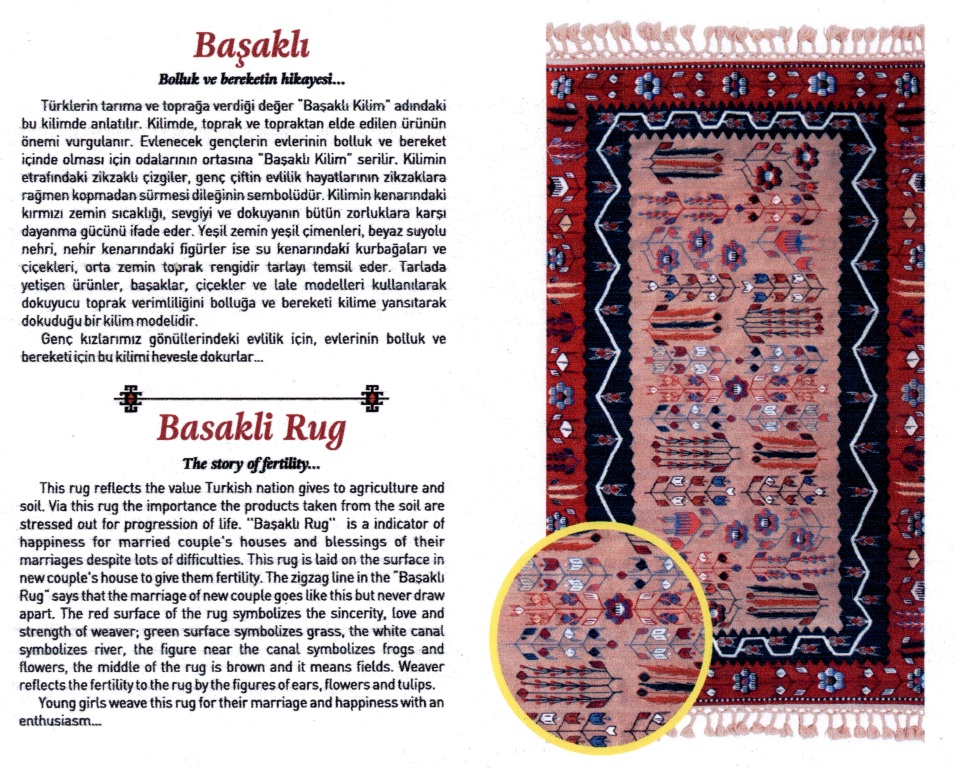
Bindalli Rug
The story of youngsters dream of setting up a happy life…
The rectangular figures in this rug symbolizes the families of newly married couples. Other sixedge figures symbolizes their children. This is why these figures are regarded as the symbols of newly married couples thriving in life and certainty they will have in their life. Figures both below and above the shapes show the good wishes of elder people for the newly married couples. These rugs are given to bride and groom by their mothers as marriage present.
These figures are woven to the rug with utmost enthusiasm for lovers to come together, for a happy family and for the children…

Bitirakli – Bıtıraklı
The story of a Turkmen bride and her mother-in-law
Turkmen bride provides additional income to her family by weaving a rug as much as possible. Yet her mother-in-law wants to put the rug to her own house. The bride doesn’t accept this but the mother-in-law is persistent in her wish. Seeing this, the bride collects a plant with spikes called ‘Sawatch’ and puts them in the middle of the rug. When the mother-in-Law steps upon the rug barefeet, she starts toyed out. Then she throws the rug at bride’s face and caused an injury of her. This story of an innocent bride gave the name ‘Bittralite to the rug. The plants in the middle represents the bitirak plants and the figures around the rug represents the mother-in-law.
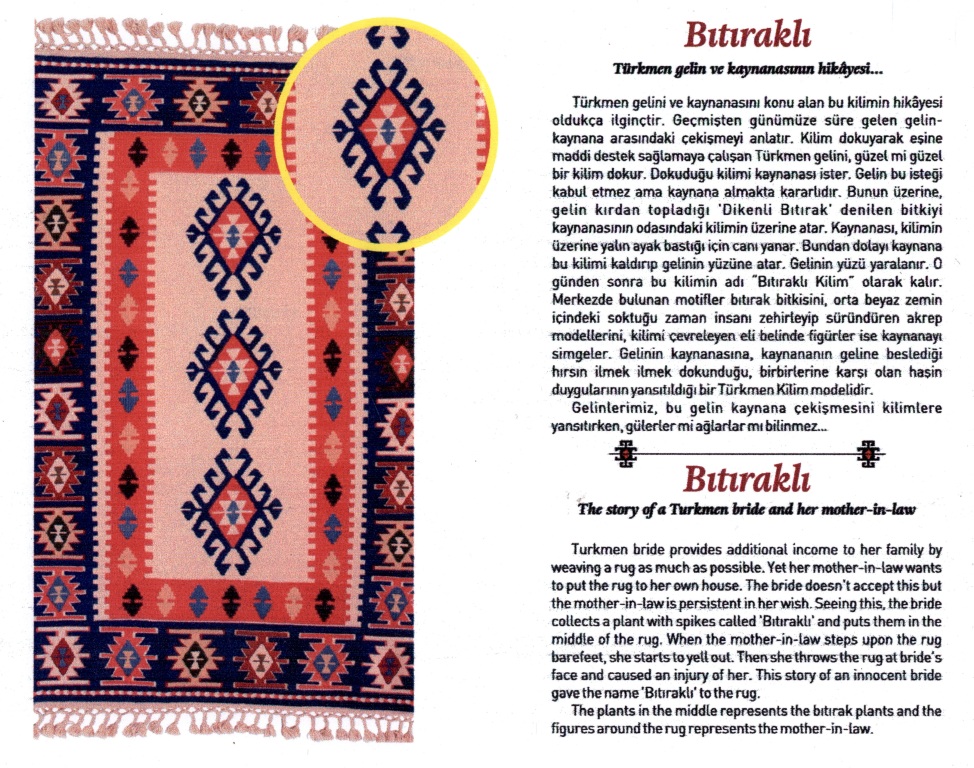
Dragon Rug
The story of a mighty dynasty… The dragon that gives its name to rug is a mytological creature which has feet like a lion’s and tail like a snake’s and has wings. The dragon is the owner of the air and water. It is believed that the flying of the dragon brings spring rains and it is the protector of the treasuries. The geometrical shapes used in the middle of the rug represents the greatness of the Selcuktu Empire. The flower figures inside represents the happiness of the people. Blue color represents the the highness of the empire. The finger figures surrounding the blue color is the protector of the people against the evil. The red color represents the welfare. The dragon figure used in the outer side and inside of the rug representing the loyal Turkish soldiers. The power of the mighty Selcuklu dynasty is weaved into this rug already for hundreds of years…
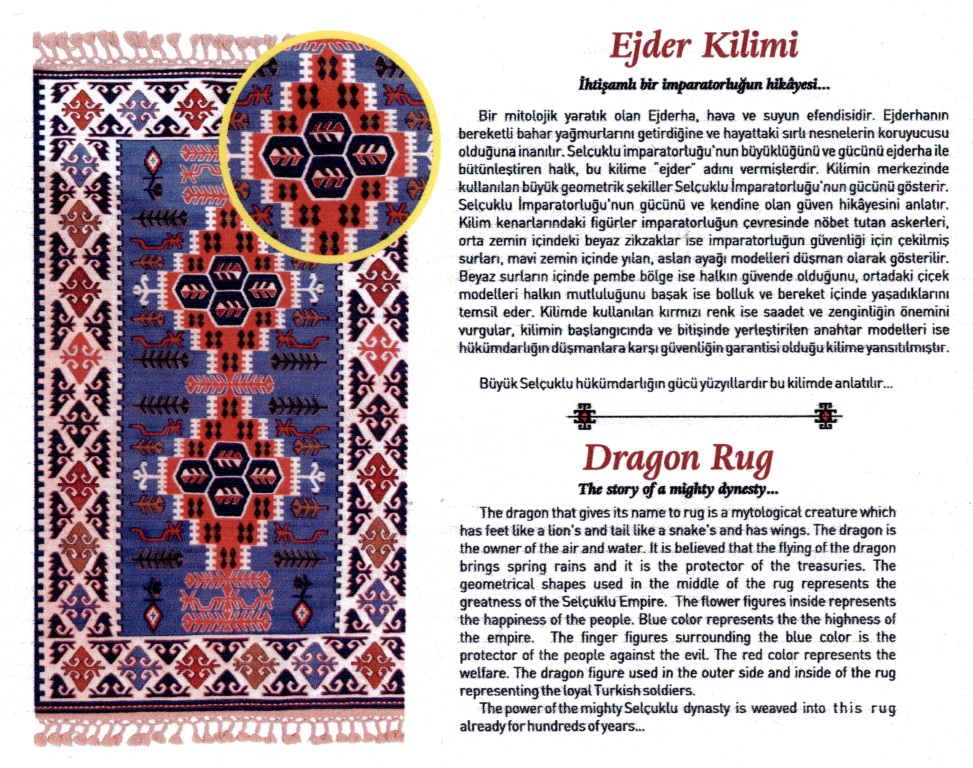
Life-Span Tree
The story of a nation’s struggle for freedom.
The story of a nation’s struggle for freedom has been taken as a source of inspiration for this rug. The plane tree, which is the mythological symbol of Turkish people has been taken as an example for this figure. Every branch in the rug represents different clans of Turkish people. At the same time, they show that they all come from the same root. On the other hand, the birds on the branches represent the freedom of Turkish people -and their wish of owning the sky and the land altogether. This is why this rug has been called the The Life- Span Tree”. The size of the tree symbolizes the greatness and permanence of the state. The people figures around the tree symbolize the ivincible Turkish soldiers, who are loyal to the state.
The weavers carrying nationalistic enthusiasm have reflected our emotions.

Konya Figure
The story of the spiritual peace going towards god…
The tear drops in the middle represent the loyalty of Turkish people to god and the iron bars represent protection from the wickedness. The figures in the frame represent the-Semazens” that whirl with love of god and the white color represents their cleanness. The hand figures both at the top and end of the rug represent the fact that whatever comes from god goes to people for their happiness. With the gravestones used in the rug temporariness of life is pointed out.
This rug reflects the spiritual emotions with great enthusiasm…
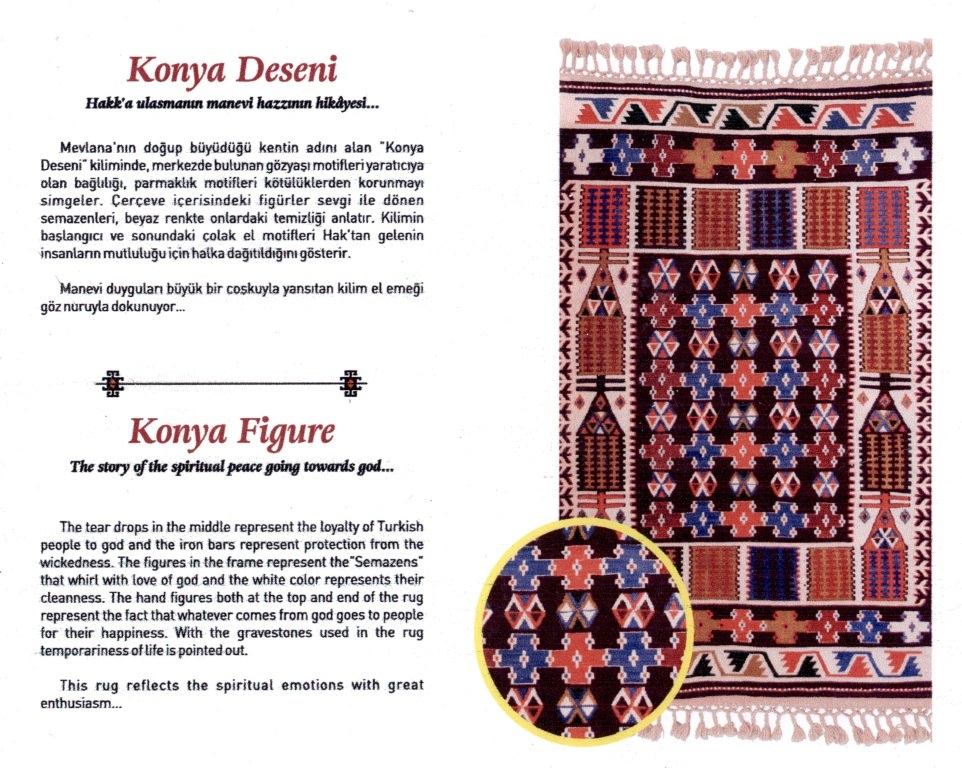
Muskali Rug – Muskalı
The story of a Peaceful lift away from evil eyes…
The belief of “Evil Eye” among people in Anatolia is very common. Looks of some people are thought to be so powerful that they cause wickedness, harm, bad tuck and even death to people. “Muska- is a magical talisman which is betived to protect the wearer from dangerous incoming factors. The figures of Muska are thought to protect the weaver and owner of the rug from Evil eye. The rug consists of eye, star, finger and muska figures. The eye in the center of the rug symbolizes welfare, fertility and protection against evil eye. The star figure is used to show that the person who is protected by Muska win be rich. The finger figures around the rug have been used for protection against wickedness. Women tied to their beliefs strictly, become pure from their badness while weaving this rug.

Otag – Otağ
The story of a nation’s finding Its land on which they live for centuries.
This rug symbolizes the Turks settling down. Every motif symbolizes a house and the area in the center tells the free dam and presence of living together. It also stresses the importance of women in Turk nation. Our women weave Turk women’s tie to life, love of family, the importance that they give to their house and the happiness of settling down to the rugs knot by knot.
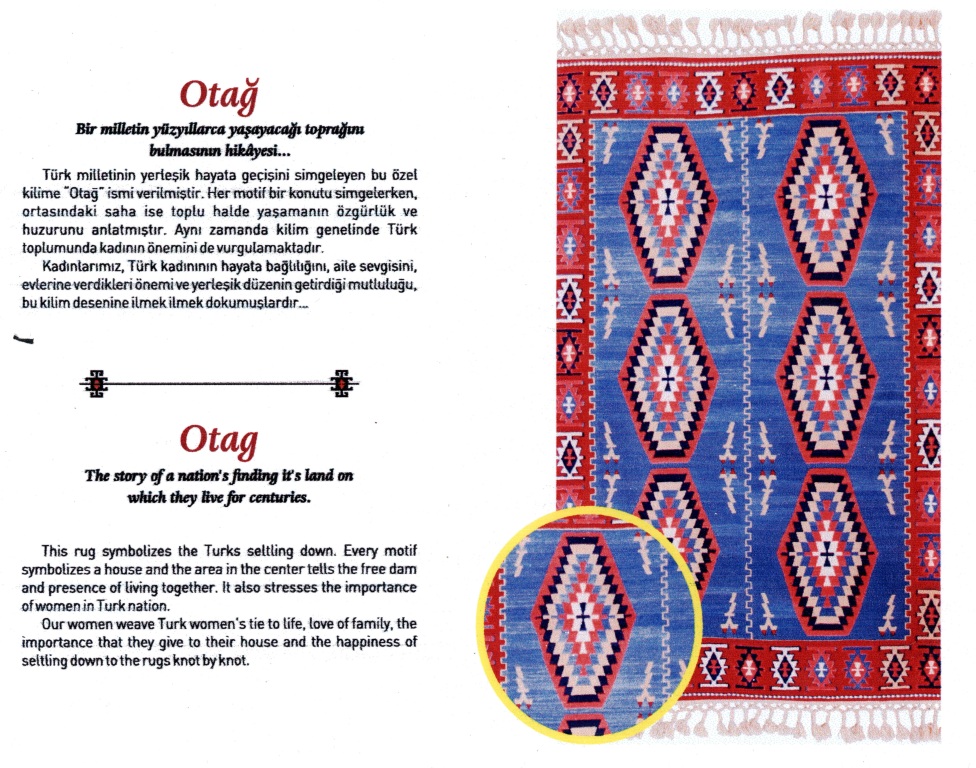
Sac Bagli – Saç Bağlı
The story of the love of young girls…
Because of their tradition and religious belief Turkish girls wear a special kind of veil called ‘ciga’ which is used for the implication of girls marriage wishes to their elders. This figure comes from this tale. This is why ‘Sac Bagti rug’ has been the symbol of end of dowry for a candidate girt for marriage. Scale images represent the justice of Turkish people whereas figures that surrounds the outer frame represent single girls.
Our young girls weave this rug by heart if they are realty in love…
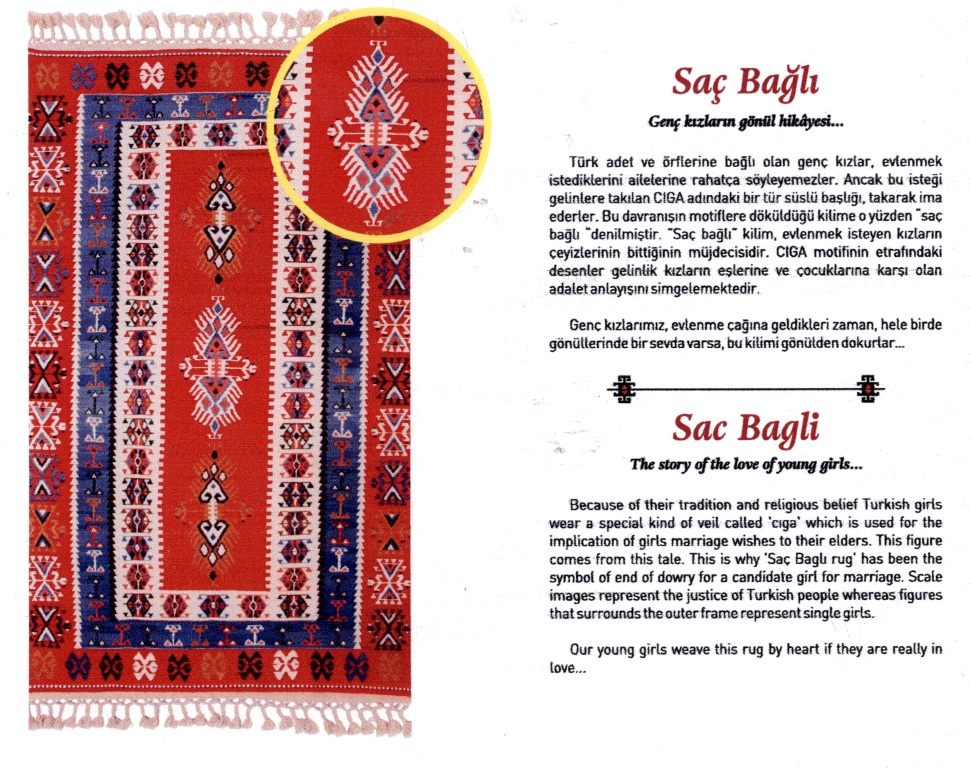
Seleser
The sad story of the beautiful bride…
At the time of Ottoman Empire, a Turkoman bride sending her husband to the army, showed her longing and yearning to the rug she weaved. When she heard that her husband has become a martyr in the east of Anotolia, in rebellion, she threw the rug to the river in front of her house and the flood took the rug away the ones who found the ruh called it SELESER for they know her pain very wet The figures in the centre are symbolizing the river and the figures around them symbolizes deathand tears.
As this rug is woven as if the tears of the bride passes through the rug…
